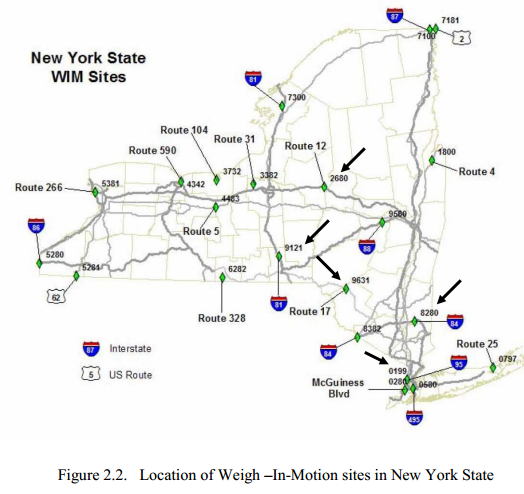Year - 2013
Load and Resistance Factor Rating in New York State
Project Description

The New York State Department of Transportation (NYSDOT) intends to revise its current policies to adopt LRFR as the analytical method for load rating and load posting of bridges and for evaluating overweight permit vehicles. To that end, new procedures similar to current NYSDOT procedures but based on the LRFR methodology need to be developed.
The Use of Large Scale Datasets for Understanding Traffic Network State
The goal of this proposal is to develop novel modeling techniques to infer individual activity patterns from the large scale cell phone datasets and taxi data from NYC. As such this research offers a paradigm shift from traditional transportation modeling by using large scale, disaggregate data and provides an unique perspective to understand the complex interactions among human behavior, urban environments and traffic patterns.
Evaluation of the Cooperative Multi-Carrier Delivery Initiatives
In the last several years there has been a surge of interest in fostering more sustainable logistical operations in urban areas. Under the umbrella of the generic term City Logistics, these initiatives try to take advantage of the coordinating power of a municipal government to convince urban delivery companies to participate in collaborative schemes that by reducing truck trips, increasing the utilization of trucks, or both, may reduce the negative externalities associated with urban truck traffic.
Development of Traffic Performance Metrics Using Real-time Traffic Data
New York City Department of Transportation (NYCDOT) over the past few years has been upgrading its Intelligent Transportation Systems (ITS) infrastructure. Specifically NYCDOT has been installing Advanced Solid State Traffic Controllers (ASTC), a city wide wireless network (NYCWiN), and a sophisticated Traffic Control System (TCS) in the Traffic Management Center (TMC).
Metrics, Models and Data for Assessment of Resilience of Urban Infrastructure Systems
Over the past century, our nation has experienced dramatic changes in demographics, and existing sociotechnical systems have become more complex and increasingly networked. To complicate matters, our cyberphysical infrastructure has not been maintained, causing unexpected vulnerabilities and cascading failures (ASCE, 2009; AWWA, 2001). As extreme events frequency and magnitude of resulting disasters have increased, emergent behavior, unexpected performance response, and lack of resilience have been noted (Sanford Bernhardt and McNeil, 2008).
Finite Element Model Updating and Damage Detection for Bridges using Vibration Measurements
This project focuses on the development of methodologies for obtaining reliable Finite Element (FE) models of bridges from measurements of their structural response to ambient as well as earthquake and wind excitations. Comparing such models from different times, for example before and after an earthquake or before and after a maintenance/rehabilitation operation, can provide information on the presence of structural damage and/or on the effectiveness of a rehabilitation solution.
Seismic Evaluation and Retrofit of Deteriorated Concrete Bridge Components
Project Description:Corrosion of steel bars in reinforced concrete structures is a major durability problem for bridges constructed in the New York State (NYS). The heavy use of deicing salt compounds this problem. Corrosion of steel bars results in loss of steel cross section, deterioration of bond between concrete and reinforcing bars, and more important, in most cases, it results in unsymmetrical concrete section that is susceptible to shear stresses produced by torsion.
Development of In-Service Monitoring Tools for Long-Span Bridges Using Advanced Sensor Networks
The long-term operation and management strategy for long-span suspension bridges requires a suite of monitoring tools, starting with bridge structural health monitoring and extending to traffic monitoring and homeland security applications. This project will investigate the status of state-of-the-art technologies needed to improve the overall safety, reliability, availability, and longevity of long-span bridges.
Effectiveness of Social Media Among Transportation Providers in the New York City Region
This research has investigated the interactions of social media and transportation in the New York City Region, conducted both by public agencies and private companies. Transportation providers must disseminate often urgent messages about delays or incidents, and in light of the explosion of social media throughout public and private industries (approximately 800 million people are on Facebook#), it is essential that they seek out their audience where it is, rather than the converse.



